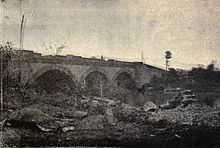February 4, 1899: The cold war becomes a hot war
The conventional wisdom believes that the Philippine-American War commenced on Feb. 4, 1899. On that date, there was an exchange of rifle fire on the San Juan Bridge outside of Manila. The American soldier on the bridge was Private William Grayson of the First Nebraska Volunteer Infantry. We know little or nothing about the Filipino soldier.
The bridge incident on Feb. 4, 1899, did not start the Philippine-American War. It could be argued that the exchange of gun fire was a contributing spark, but the slow burning fuse had been ignited on Aug. 13, 1898. During the Mock Battle of Manila, the Filipino soldiers and officers had been deceptively excluded by their supposed Americans allies from their hard-fought victory against Spain.
During the six months from Aug. 13, 1898, to Feb. 4, 1899, there was a cold war between the Americans and President Emilio Aguinaldo’s forces. At times, the cold felt more hot than cold. The volatile situation between the two parties could have exploded anytime during the six months of the cold war. The final trigger just happened to explode on Feb. 4, 1899.

On Feb. 4, 1899, there was an exchange of rifle fire on the San Juan Bridge (in photo) outside of Manila. Photo from Wikipedia
Both the United States and Aguinaldo’s forces felt the need to blame each other for the bridge incident on Feb. 4, 1899. Both sides had logical arguments to support their cause. However, their arguments were irrelevant. A transition from a cold war to a hot war was inevitable. The outbreak of war could have happened on Aug. 14, 1898, or Feb. 5, 1899, or any day in-between.
The Americans justified their position in the Philippines by quoting the Treaty of Paris. To them, they had won the Philippine Islands during the Spanish-American War. They had earned and deserved by the treaty the right to annex the islands. To the Filipinos, under the leadership of President Aguinaldo, they had declared independence from Spain in June 1898. They had served the Americans as allies in the fight against Spain, and they had established a Constitutional Republic. They had successfully completed every appropriate challenge.
When both parties adamantly think that a large piece of real estate, the Philippines, belongs only to them, then a conflict was inevitable. Unfortunately, thousands of Americans and Filipinos died needlessly during the Philippine-American War.
There was a common belief that the Philippine-American War was fought conventionally by both parties from February 1899 until November 1899. After November 1899, the Filipinos changed to a guerrilla strategy to defeat the technologically superior American forces.
This interpretation was wholly incorrect. In February 1899, American soldiers traveling from Manila to the front lines and vice versa were routinely attacked by Filipino guerrilla forces behind American lines. There were multiple incidences of arson by Filipino soldiers behind American lines. The Filipino strategy from the beginning was a simultaneous combination of conventional and guerrilla warfare.
Once the Americans significantly advanced on the Filipino lines on Feb. 5, 1899, there was another common belief that the Americans halted their advance abruptly to wait for reinforcements and that this was a time of relative calm.
There was not one calm day on the front lines from Feb. 14 to March 1, 1899. The Americans were hunkering down in their trenches day and night. There were ubiquitous Filipino sharpshooters firing on careless American in the trenches. On Feb. 22 to Feb. 24, 1899, General Antonio Luna launched a direct frontal counterattack on the American lines. The fighting was intense. The front lines in the early days of the Philippine-American War were never quiescent.
There was another common belief in the Philippine-American War that the average American soldiers did not support American annexation of the Philippines. During the cold war phase, there was significant opposition by common American soldiers to annexation. The soldiers had only enlisted for the Spanish-American War. Since the Treaty of Paris was signed, they thought that they should be sent home immediately. Some soldiers wrote their local newspapers to complain about their situation and the lack of leadership by their officers. Based on what they witnessed in the Philippines, some soldiers thought that the Filipinos could govern themselves.
When the fighting commenced on Feb. 4, 1899, the opposition to the annexation of the Philippines by the common soldiers ended quickly. Once the Filipino soldiers started shooting at American soldiers, their attitudes changed rapidly. There might have been some minor opposition, but in general, opposition was negligible. The common soldiers were onboard with the war.
On Feb. 4, 1899, very few people thought that the Philippine-American War would last long. Unfortunately, the war was only at its beginning stage. There was more than two years of fighting left and longer in a few other areas of the Philippines. What appeared to be easy on the surface never became easy in reality.
Dennis Edward Flake is the author of three books on Philippine-American history. He is a public historian and a former park ranger in interpretation for the National Park Service at the Eisenhower National Historic Site in Gettysburg, PA. He can be contacted at: flakedennis@gmail.com

